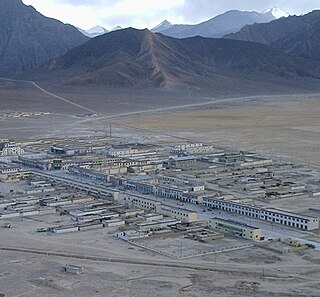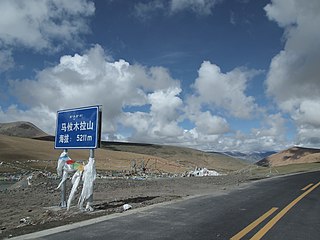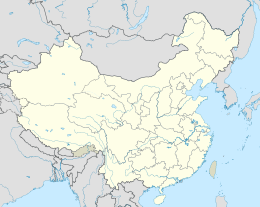
Nepal measures about 880 kilometers (547 mi) along its Himalayan axis by 150 to 250 kilometers across. It has an area of 147,516 km2 (56,956 sq mi).

The Brahmaputra is a trans-boundary river which flows through Tibet (China), Northeastern India, and Bangladesh. It is known as Brahmaputra or Luit in Assamese,Yarlung Tsangpo in Tibetan, the Siang/Dihang River in Arunachali and Jamuna River in Bengali. It is the 9th largest river in the world by discharge, and the 15th longest.

Mount Kailash is a mountain in Ngari Prefecture, Tibet Autonomous Region of China. It lies in the Kailash Range of the Transhimalaya, in the western part of the Tibetan Plateau. The peak of Mount Kailash is located at an elevation of 6,638 m (21,778 ft), north of the western trijunction of the border between China, India and Nepal.

Samzhubzê District is a district in the Tibet Autonomous Region of the China, and the administrative center of the prefecture-level city of Shigatse. Prior to 2014 it was known as the county-level city of Shigatse. It was the ancient capital of Ü-Tsang province and is the second largest city in Tibet with an estimated population of 117,000 in 2013. Samzhubzê is located at the confluence of the Yarlung Tsangpo River and the Nyang River, about 250 km (160 mi) southwest of Lhasa and 90 km (56 mi) northwest of Gyantse, at an altitude of 3,840 metres (12,600 ft).

Lake Mansarovar, also called Mapam Yumtso locally, is a high altitude freshwater lake fed by the Kailash Glaciers near Mount Kailash in Burang County, Ngari Prefecture, Tibet Autonomous Region, China. It is the source of the Indus River. The lake along with Mount Kailash to its north are sacred sites in four religions: Hinduism, Jainism, Buddhism and Bön.

The Yarlung Tsangpo Grand Canyon, also known as the Yarlung Zangbo Grand Canyon, the Tsangpo Canyon, the Brahmaputra Canyon or the Tsangpo Gorge, is a canyon along the Yarlung Tsangpo River in Tibet Autonomous Region, China. It is the deepest canyon in the world, and at 504.6 kilometres (313.5 mi) is slightly longer than the Grand Canyon in the United States, making it one of the world's largest. The Yarlung Tsangpo originates near Mount Kailash and runs east for about 1,700 kilometres (1,100 mi), draining a northern section of the Himalayas before it enters the gorge just downstream of Pei, Tibet, near the settlement of Zhibe. The canyon has a length of about 240 kilometres (150 mi) as the gorge bends around Mount Namcha Barwa and cuts its way through the eastern Himalayas. Its waters drop from about 2,900 metres (9,500 ft) near Pei to about 1,500 metres (4,900 ft) at the end of the Upper Gorge where the Po Tsangpo River enters. The river continues through the Lower Gorge to the Indian border at an elevation of 660 metres (2,170 ft). The river then enters Arunachal Pradesh and eventually becomes the Brahmaputra.

The Karnali River, called Ghaghara River in India, Mapcha Tsangpo in Tibet, and the lower Ghaghara in Awadh called Sarayu River, is a perennial trans-boundary river that originates in the northern slopes of the Himalayas in the Tibetan Plateau, cuts through the Himalayas in Nepal and joins the Sharda River at Brahmaghat in India. Together they form the Ghaghara River, a major left-bank tributary of the Ganges. With a length of 507 km (315 mi), it is the longest river in Nepal. The total length of the Ghaghara up to its confluence with the Ganges at Revelganj in Bihar is 1,080 km (670 mi). It is the largest tributary of the Ganges by volume and the second largest by length after Yamuna.

The Friendship Highway is an 800-kilometre (500 mi) scenic route connecting the capital of Tibet, Lhasa, with the Chinese/Nepalese border at the Sino-Nepal Friendship Bridge between Zhangmu and Kodari. It includes the westernmost part of China National Highway 318 (Shanghai-Zhangmu) and crosses three passes over 5,000 m (16,400 ft) before dropping to 1,750 m (5,700 ft) at the border.

Purang County or Burang County (Tibetan: སྤུ་ཧྲེང་རྫོང; Chinese: 普兰县) is an administrative division of Ngari Prefecture in the Tibet Autonomous Region (TAR) of China. The county seat is Purang Town, known as Taklakot in Nepali. The county covers an area of 12,539 square kilometres (4,841 sq mi), and has a population of 9,657 as of 2010.

Nyalam is a small town in and the county seat of Nyalam County in the Shigatse Prefecture of the Tibet Autonomous Region, near the Nepal border. It is 35 km from Zhangmu town in the same county, which is the point of entry to Nepal. Nyalam is situated at 3,750 metres (12,300 ft) above sea level.

The ongoing pollution of the Ganges, the largest river in the Indian subcontinent, poses a significant threat to human health and the environment. The river provides water to about 40% of India's population across 11 states. It serves an estimated population of 500 million people, more than any other river in the world.

Drongpa County or Zhongba County (Tibetan: འབྲོང་པ་རྫོང; Chinese: 仲巴县) is a county of Shigatse Prefecture in China's Tibet Autonomous Region. Located in the western part of Central Tibet, it is the birthplace of the Tsangpo River (Brahmaputra). Zhongba is said to mean "place of wild yaks" in Tibetan. The county seat is at Labrang, which is also called the "Drongpa Township".

The Yarlung Tsangpo, also called Yarlung Zangbo and Yalu Zangbu River is the upper stream of the Brahmaputra River located in the Tibet Autonomous Region, China. It is the longest river of Tibet and the fifth longest in China. The upper section is also called Dangque Zangbu meaning "Horse River."

Purang or Burang, known as Puhreng in Tibetan, (Nepali:ताक्लाकोट) is a town which serves as the administrative center of Purang County, Ngari Prefecture of the Tibet Autonomous Region (TAR), China. The town lies at an altitude of 3,900m in the valley of the Karnali River. The town spans an area of 3,257.81 square kilometres (1,257.85 sq mi), and has a permanent population 6,047 as of 2010, and a hukou population of 4,477 as of 2018. To the south are Gurla Mandhata and the Abi Gamin ranges. Lake Manasarovar and Mount Kailash are to the north. This region is the mythological and actual river nexus of the Himalaya with sources of the Indus, Ganges and Yarlung Tsangpo/Brahmaputra all within 110 kilometres (70 mi) of Purang.

The Rutog Town , called Rituzhen in Chinese, is a town and the seat of Rutog County in the far western Tibet Autonomous Region. It is also a major military base for China near the disputed border with India allowing it to press its claims militarily.
The Zangmu Dam (藏木) is a gravity dam on the Yarlung Zangbo/Brahmaputra River 9 km (5.6 mi) northwest of Gyaca in the Tibet Autonomous Region of China. This dam is built a few kilometers from the Bhutan-India border. The purpose of the dam is hydroelectric power production using run-of-the-river technology. It is part of the Zangmu Hydropower Project and supports a 510 MW power station. Construction began in 2009 and the first generator was commissioned in November 2014. The last became operational on 13 October 2015. It is the first dam on the Brahmaputra/Yarlung Zangbo River and has caused controversy in India.

Sengge Zangbo, Sengge Khabab or Shiquan He is a river in the Ngari Prefecture in the Tibet Autonomous Region, China that is the source stream of the Indus river, one of the major trans-Himalayan rivers of Central and South Asia. The river rises in the mountain springs north of the Manasarovar lake, and 300 km (190 mi) downstream joins the Gar Tsangpo river near the village of Tashigang. Although it is thereafter called the Indus internationally, the Tibetans continue to regard the combined river to be Sênggê Zangbo as it flows into Ladakh.

Hilsa is a village in the northwestern corner of Nepal bordering Tibet Autonomous Region (China), where the Humla Karnali crosses from the Tibetan Plateau into the mountain regions on its descent to the Ganges. Hilsa is in Humla District, Karnali Zone facing Burang County, Ngari Prefecture, Tibet region of China.

Mayum La, also known as Mariám La, is a mountain pass to the east of Lake Manasarovar. It separates the drainage divide of the Dangque Zangbo, which is a headwater of Yarlung Tsangpo (Brahmaputra), and Langqen Zangbo in Tibet.
Chakgang, or Jaggang (Tibetan: ལྕགས་སྒང, Wylie: lcags sgang; Chinese: 甲岗; pinyin: Jiǎ gǎng, often transliterated Jiagang), is a village in the Rutog County, Ngari Prefecture in the Tibet region of China. It is on a wide plain at a major junction in the Maga Zangbo valley where several tributary streams join the river. It is traditionally known for its barley cultivation. The area was used as a base for Chinese military operations in the Demchok sector in the 1962 Sino-Indian War.




















